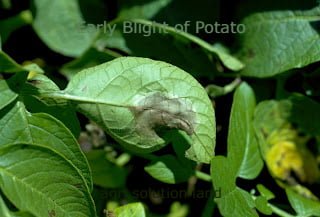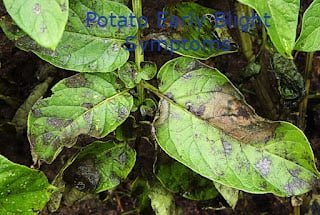Early Blight of Potato
Early blight of potato caused by the fungus Alternaria solani. The disease attacks the plant’s leaves and stems, reducing the crop’s output, fruit size, and storage viability. The value of crops affected by this disease drops significantly. The occurrence of early blight is global and occurs primarily in areas, in the United States, Australia, India, China, Russia, Ukraine, Germany, and Bangladesh. In recent years, an early blight of potatoes has emerged as a major issue for potato farmers. When it comes to Polish weather, the early blight of potatoes often strikes between 42 and 64 days after the potatoes have been planted. The early blight of the potato causal agent mostly infects the plant’s leaves, especially the foliage of more susceptible varieties. Early blight appears on potato tubers in some years.
Alternaria Solani In Potato
Alternaria solani in potato is a type of fungal disease that affects potato plants. It is also known as early blight. This disease is caused by a fungus called Alternaria solani. It usually starts on the older leaves of the plant, causing dark spots with concentric rings that look like a target. Over time, the leaves may turn yellow and die. If not controlled, it can reduce the yield and quality of the potatoes. It spreads through spores carried by wind, rain, or contaminated soil. Proper crop rotation, fungicides, and removing infected plants can help manage this disease.
Alternaria Potatoes
Early blight of potatoes is caused by the fungus Alternaria solani, which affects potato plants. Early blight is a common disease in potatoes and can also affect other plants in the Solanaceae family, such as tomatoes. Symptoms of early blight in potatoes include:
Leaf Lesions: Dark brown to black lesions with concentric rings develop on the leaves, typically starting from the lower leaves and moving upwards. The lesions may have a target-like appearance. Stem Lesions: Lesions can also occur on the stems, appearing as dark brown to black sunken spots. Fruit Infection: In severe cases, the disease can affect the tubers, causing dark, sunken lesions on the surface. Leaf Yellowing and Defoliation: Infected leaves may turn yellow and eventually die, leading to defoliation and reduced plant vigor. Early blight can spread rapidly under favorable conditions such as warm and humid weather.
It can overwinter in infected plant debris in the soil, so crop rotation and proper sanitation practices are important for managing the disease.
Potatoes History and Diseases
The most popular crop, potatoes brings in a lot of money for farmers and the country as a whole. Potatoes provide all of the necessary nutrients for a balanced diet and lifestyle. The potato is one of the most widely grown vegetables worldwide. The biggest obstacle to growing healthy vegetables commercially is the spread of disease. Low yield and poor quality are the results of potato disease. Early blight of potato is one of the most dangerous diseases.
Symptoms of Early Blight of Potato

The projected damage caused by the early blight of potato varies greatly between different parts of the world. Reducing yields by up to 25% nationally and 60% locally, says Reinoch. Fry states that there is often a 20-30% drop in yield that has been documented. High regional losses in Poland due to early blight were observed, however, most were associated with cultivars known to be susceptible to this disease. Fungi belonging to the Alternaria genus specifically, Alternaria alternata and Alternaria solani are responsible for the illness (the latter appearing mostly in southwestern Poland).
Since the onset and progression of sickness produced by these two fungus species are identical in terms of morphological symptoms, their prevalence is calculated together. Varieties of a plants can exhibit varying degrees of illness, depending on the strain.
Early blight of Potatoes is caused by

Circumstantial factors that promote infection and illness breakout include high temperature (optimum 25-26 °C for A. alternata and 26-27 °C for A. solani), and dry, and humid periods that alternate. In recent years, however, fungi have been seen to adapt to colder conditions. The fungus Alternaria spp., commonly responsible for early blight, is a typical necrotrophic fungus that preys on weak or aged plant tissue. Virus-infected potato plants are also more likely to be affected by early blight.
Early Blight of Potato Causal Organism
Early blight of potato is caused by the fungal pathogen “Alternaria solani”. This fungus primarily affects potato (Solanum tuberosum) and tomato (Solanum lycopersicum), leading to characteristic leaf spots, defoliation, and reduced tuber yield. The disease is favored by warm, humid conditions and commonly spreads through infected plant debris and wind-dispersed spores.
Disease Cycle of Early Blight
There can be many cycles of infection throughout a season, making Alternaria solani a polycyclic pathogen. Overwintering inoculum is the primary pathogen that attacks newly planted potatoes and tomatoes. The pathogen survives the winter in the form of mycelium or conidia in plant detritus, soil, infected tubers, or other host plants in the same family. The early blight fungus survives the winter on contaminated remnants of the preceding crop. In addition to potatoes, the fungus can also live on other members of the Solanaceae family.
The pathogen can live for a long time in soil because of the decaying remains of infected crops. It can survive the winter on weeds and volunteer hosts. A source of overwintering inoculum for the early blight of potatoes is chlamydospores, which can help the pathogen persist in or on the soil even when temperatures drop below freezing. Infectious inoculum can live in soil residues for up to 8 months in unharvested areas. Hyphae with more melanin increase their resistance to lysis. Spores can live longer in dry, fallow fields and on infected trash and seed.
Early Blight of Potato Treatment, Management & Control
Implementing an integrated disease management strategy is essential for effectively managing this disease. Cultural methods, resistant varieties, and foliar fungicides are the main weapons in the fight against this disease.
Early Blight of Potato Control Cultural Practice
Inoculum levels for successive plants can be decreased through cultural techniques such as crop rotation, destroying and incineration plant detritus, and eliminating weed hosts. Rotation with non-host crops (such as small grains, corn, and beans) minimizes the quantity of initial inoculum available for disease onset since A. solani survives in plant debris in the field from one growing season to the next. The following are some other methods of cultural management:
- In order to grow healthy plants, it’s essential to use pathogen-free, certified seeds of a resistant variety.
- Potatoes shouldn’t be dug for at least a few days (ideally two weeks) following vine death. By doing so, you can boost the tubers’ natural defenses against the early blight fungus.
- Immediately following harvest, bury all leftover plant material and volunteer potatoes.
- Keep tubers at 40 degrees Fahrenheit in a place that is clean, dry, dark, and well-ventilated.
- Be gentle when handling tubers to prevent them from getting bruised.
- Pick fields that have plenty of airflow and drainage, have a few dense plant stands and don’t get soaked by watering from above for too long.
- Don’t water plants when the weather is cool and gloomy, and make sure they have time to dry before evening.
- Since A. solani cannot infect through an unbroken periderm, tubers should be stored in a way that encourages quick suberization.
Early Blight of Potato Chemical Control
Applying foliar fungicides from the beginning of the growing season to vine mortality is the most popular and successful strategy for controlling the early blight of potato. More fungicide formulations have been approved for use against early blight than against any other potato disease combined. Applying contact fungicides often during the incubation period of the disease is advised.
Three to four sprayings with a systemic or contact fungicide from the time of flowering onward are recommended. A systemic fungicide should be sprayed right away if symptoms emerge before flowering. Reduced spraying is possible without considerable yield loss if the timing of the first and subsequent fungicide applications is optimized. Beginning at bloom, or according to a weather-timed spray schedule (such as Blitecast), a protectant-type fungicide with the active ingredient chlorothalonil, maneb, or mancozeb should be applied on a 7- to 10-day spray schedule, and continuing until the foliage dies naturally or is killed artificially by a “vine-killing” agent.
Biological Control of Early Blight Potato
Biological control of early blight in potatoes involves the use of beneficial microorganisms and insects. These can be used to reduce the severity of the disease, allowing the plants to develop more fully. Beneficial Microorganisms:
- Trichoderma harzianum: This fungus is a natural enemy of early blight, and has been used in commercial production of potatoes for its ability to colonize plant roots and protect them from infection.
- Bacillus subtilis: This bacterium can be used to control early blight by producing metabolites that inhibit the growth of the pathogen.
- Pseudomonas fluorescent: This bacterium can colonize the root system of potatoes and produce metabolites that inhibit the growth of the fungus.
- Gliocladium virens: This fungus can colonize the root system of potatoes and produce metabolites that inhibit the growth of the fungus.
- Beneficial Insects:
- Ladybirds – These predatory insects are known to feed on the spores of early blight, helping to reduce the severity of an outbreak.
- Green lacewings – These predatory insects feed on the spores of early blight, helping to reduce the severity of an outbreak.

